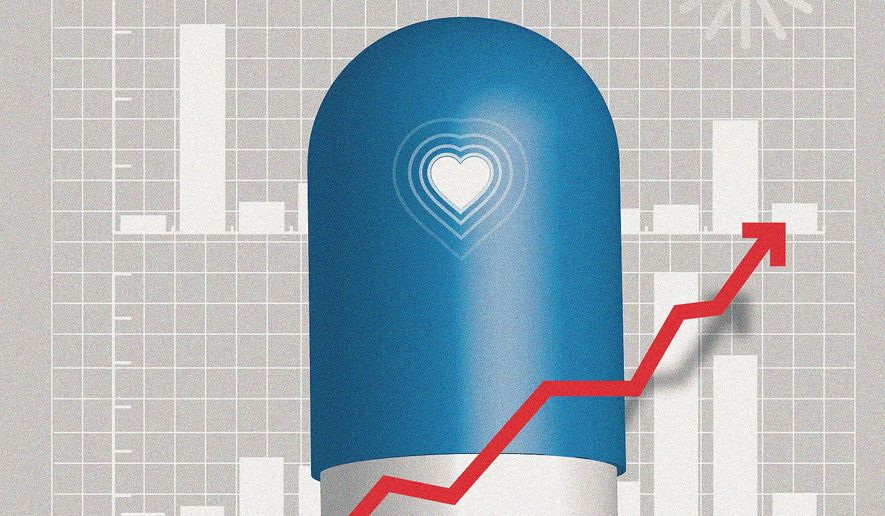OPINION:
In the debate over drug pricing, many believe that drug-makers spend more on advertising than on research and development and, consequently, prices can be cut without damaging innovation.
This is inaccurate, and our research shows why.
We divided publicly listed U.S. drug-makers aggregative revenue over 40 years into seven categories. We found that analyses of drug industry economics by the Congressional Budget Office and others have missed the expenditures by larger drug companies to purchase drugs developed by smaller, sometimes private, firms. Many large companies routinely buy patents or medicines in development from smaller companies whose research and development data are not publicly available.
Fortunately, accounting standards require public companies to report an amortization expense for these acquisitions. Combining firms’ research and development and amortization expenses gives a more accurate picture of how much pharmaceutical companies spend on innovation as a percent of sales revenue.
The income statements we examined indicate that drug manufacturing has changed dramatically over the past four decades. Raw materials and the direct labor costs of making drugs dropped from an amount equivalent to about half of the industry’s sales in 1979 to only a quarter in 2018. At the same time, research and development expenditures increased from 4.6% of sales revenue in 1979 to 19% in 2018.
The annual costs of purchases of drugs developed by other companies rose from 0.1% of sales in 1979 to 5.2% in 2018. In 2018, publicly traded U.S. drug-makers spent 24% of sales revenue developing drugs internally and acquiring medicines developed by others. That was almost the same amount as the costs for raw materials and direct labor.
Moreover, every year since 1982, the pharmaceutical industry’s annual spending on research and development has exceeded that spent on advertising. As a percentage of sales revenue, the industry’s total advertising dropped from 6% in 1970 to 3% in 2018.
These results contradict claims made against individual companies. For example, the American Hospital Association asserted that “eight out of 10 major drug manufacturers spend more on advertising than on research and development.” A doctor-led website claimed that based on the 2019 financial statements, the largest pharmaceutical companies such as Pfizer and Eli Lilly all spent significantly more on marketing than on research and development of drugs.
Those claims are wrong, and those making them have confused some basic accounting terms.
They attribute all expenses typically labeled “Selling, General and Administrative” to marketing and advertising. However, the SG&A expenses include all expenses that a company incurs in generating sales. For example, for 2019, Pfizer included in SG&A “the internal and external costs of marketing, advertising, shipping and handling, information technology and legal defense.”
Among Pfizer’s $14 billion SG&A expenses, advertising is only $2.4 billion, far smaller than the $8.7 billion it spent on researching and developing drugs to improve patients’ lives.
Similarly, Eli Lilly spent just $1.1 billion on advertising in 2019, a fraction of its SG&A expenditures (totaling $6.2 billion). The $1.1 billion it spent on advertising was dwarfed by the $5.6 billion it spent on researching and developing new life-saving drugs.
The entire industry’s aggregate operating profits (earnings before interest and taxes) increased from 15% of sales in 1979 to 23% in 2018. At first glance, that would suggest that drug companies earn high profits.
However, these numbers do not reflect the profitability of individual companies. From 1989 to 2018, over 50% of the publicly listed U.S. drug-makers had negative operating profits each year. Over the same period, about 36% of the U.S. drug-makers had research and development expenses that by themselves exceeded sales.
Some believe that the pharmaceutical industry commits most of its resources to operations unrelated to the development of life-saving drugs. That’s inaccurate. The data shows that the industry spends more on research and development of new treatments and cures than anything else.
While curbing increases in prescription drug costs may be politically expedient, no one should expect that such policies can be enacted without damaging the ability of these companies to perform research that reduces suffering and saves lives.
• Joe Grogan is a senior fellow at the USC Schaeffer Center for Health Policy & Economics and served as the Domestic Policy Advisor under former President Donald Trump. John (Xuefeng) Jiang is a professor and the Plante Moran faculty fellow at Michigan State University’s Eli Broad College of Business.
- Correction: The Chinese byline of John Xuefeng Jiang was corrected.




Please read our comment policy before commenting.